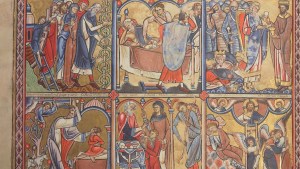The rich tradition of handcrafting illuminated manuscripts went out centuries ago, but the process has been immortalized on YouTube. Thanks to the Getty Museum’s beautifully produced video, now we can see the extent mankind once went to in order to create just one single copy of a book.
The term “illuminated manuscript” refers to the medieval tradition of illustrated literature. The illuminations were colorful and often beautifully designed artistic representations of the texts. The tradition was especially popular in the Church, which sought to educate the illiterate. These illuminations served the same function as stained-glass images, which retold the stories of the saints and the Gospels in a wordless format.
In today’s video, we see the process of making an illuminated manuscript from start to finish. To say that the job was labor intensive is an understatement. Depending on the size and number of illuminations, a single manuscript could take several years to complete.
Making parchment
The work began with making the parchment. Unlike modern wood-based papers, parchment was crafted from animal skins. Skins were soaked in a solution to loosen the hair. Then it had to be stretched and scraped for days. By expanding and thinning the leather, the workers would increase the surface area so as to produce a larger piece of parchment.
Each piece of parchment needed to be cut to size to fit each manuscript. In those days, there were no standard sizes for books, so each manuscript would need uniquely sized sheets. If the manuscript was very large, it could take dozens of pelts to produce enough parchment.
Writing and binding
Once the parchment was ready, a scribe would begin writing the text in his best penmanship. This step is where the handcrafted aspects of these manuscripts become intense. Not only did the scribe write each letter in a careful hand, but he also made his writing utensils (quills) and ink by hand. Thankfully, the parchment was thick enough to scrape away a misplaced letter here and there.
Once the writing was done, specialized artists would illuminate the manuscript. These illuminations were accented with vivid colors and precious metals. Many of the pigments were imported from distant lands and were quite valuable. Only those whose artistic skill was highly regarded were trusted to worked with such materials.
While the art is impressive, our favorite part of this short video was the binding. The binder quickly takes the viewer through the process of sewing the pages together with linen thread, binding it together at the spine, and encasing the whole thing in leather.
The fine craftspeople of Getty Museum put on an excellent show as they summarize years of work into just six minutes. While the process does seem a bit tedious, the result is a beautifully bound book with parchment pages that can survive for a thousand years.

